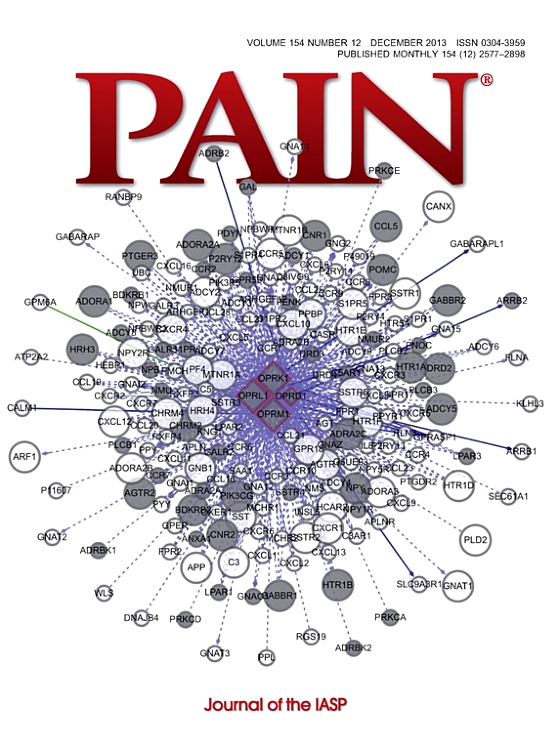Neural, psychological, and daily life evidence for a transdiagnostic process of affective dysregulation in depression and chronic widespread pain.
IF 5.5
1区 医学
Q1 ANESTHESIOLOGY
引用次数: 0
Abstract
Chronic pain and depression are leading causes of disability, frequently co-occurring and exacerbating each other. This cross-sectional study investigated putative transdiagnostic processes of affective dysregulation in fibromyalgia (FMS) and major depressive disorder (MDD) using psychometric questionnaires (Beck Depression Inventory-II, Hospital Anxiety and Depression Scale, Cognitive Emotion Regulation Questionnaire, Perceived Stress Scale, Widespread Pain Index, Somatic Symptom Disorder B Criteria Scale 12), ecological momentary assessments, and real-time functional magnetic resonance imaging amygdala neurofeedback during an emotion regulation task. We compared clinical symptoms, stress sensitivity, and emotion regulation in patients with FMS (N = 46) and MDD (N = 48) with healthy controls (N = 34). Patients with fibromyalgia syndrome and major depressive disorder reported similar psychopathological and affective dysregulation profiles, and they exhibited more psychopathology and emotion regulation deficits than healthy controls (HC). Differences between MDD and FMS were limited to pain-specific pathology in FMS (pain spread and frequency P < 0.001, intensity P < 0.05) and more rumination (P < 0.05) and self-blame (P < 0.01) in MDD. Momentary stress predicted higher subsequent pain and worse affective states across groups, with FMS and MDD exhibiting stronger stress responses (all P's < 0.05). Directly after neurofeedback training, FMS and MDD were less able to downregulate left amygdala activity than HC (P = 0.039) compared to baseline performance, and this brain marker predicted daily life psychopathology (negative affect, anxiety, and rumination, all P's < 0.05). Patients with fibromyalgia syndrome additionally exhibited unique deficits in right amygdala regulation (P = 0.004). Our findings highlight transdiagnostic affective dysregulation patterns in FMS and MDD, specific differences in emotion regulation strategies, and a potential neuronal marker of a shift towards right amygdala sensitization during affective processing in FMS.抑郁症和慢性广泛性疼痛中情感失调的跨诊断过程的神经、心理和日常生活证据。
慢性疼痛和抑郁是导致残疾的主要原因,它们经常同时发生并相互加剧。本横断面研究采用心理测量问卷(贝克抑郁量表- ii、医院焦虑和抑郁量表、认知情绪调节问卷、感知压力量表、广泛疼痛指数、躯体症状障碍B标准量表12)、生态瞬间评估、以及情绪调节任务中杏仁核神经反馈的实时功能磁共振成像。我们将FMS (N = 46)和MDD (N = 48)患者的临床症状、应激敏感性和情绪调节与健康对照(N = 34)进行比较。纤维肌痛综合征和重度抑郁症患者报告了相似的精神病理和情感失调特征,他们比健康对照组表现出更多的精神病理和情绪调节缺陷(HC)。MDD和FMS之间的差异仅限于FMS的疼痛特异性病理(疼痛扩散和频率P < 0.001,强度P < 0.05)和MDD更多的反刍(P < 0.05)和自责(P < 0.01)。瞬时应激预示着各组更高的后续疼痛和更差的情感状态,FMS和MDD表现出更强的应激反应(均P < 0.05)。神经反馈训练后,与基线表现相比,FMS和MDD降低左杏仁核活动的能力低于HC (P = 0.039),这一大脑标志物预测日常生活精神病理(负面情绪、焦虑和反刍,均P < 0.05)。纤维肌痛综合征患者还表现出独特的右侧杏仁核调节缺陷(P = 0.004)。我们的研究结果强调了FMS和MDD的跨诊断情感失调模式,情绪调节策略的具体差异,以及FMS情感处理过程中向右杏仁核敏感化转变的潜在神经元标记。
本文章由计算机程序翻译,如有差异,请以英文原文为准。
求助全文
约1分钟内获得全文
求助全文
来源期刊

PAIN®
医学-临床神经学
CiteScore
12.50
自引率
8.10%
发文量
242
审稿时长
9 months
期刊介绍:
PAIN® is the official publication of the International Association for the Study of Pain and publishes original research on the nature,mechanisms and treatment of pain.PAIN® provides a forum for the dissemination of research in the basic and clinical sciences of multidisciplinary interest.
 求助内容:
求助内容: 应助结果提醒方式:
应助结果提醒方式:


